De Havilland Sea Vixen Videos
|
Loading...
|
|
De Havilland Sea Vixen
DH.110 Sea Vixen
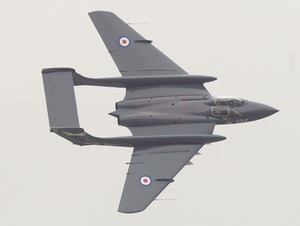
Role: Carrier-based fighter
Manufacturer: de Havilland
First flight: 26 September 1951
Introduced: July 1959
Retired: 1972
Primaryuser: Royal Navy
Number built: 145
The de Havilland DH.110 Sea Vixen was a twin boom 1950s-1960s British two-seat jet fighter of the Fleet Air Arm (the air component of the Royal Navy) designed by de Havilland. Developed from an earlier first generation jet fighter, the Sea Vixen was a capable carrier-based fleet defence fighter that served into the 1970s. Initially produced by de Havilland it was later known as the Hawker Siddeley Sea Vixen when de Havilland became a part of the Hawker Siddeley group.
Development
The aircraft was originally known as the DH.110; a twin-engined all-weather fighter, development of which started in 1946 following discussions with the Admiralty of its requirements for jet all-weather fighters. De Havilland's design shared the twin-boom layout of the de Havilland Vampire, had an all-metal structure and featured swept wings. It was to be powered by two Rolls-Royce Avon engines, each capable of 7,500lb of thrust, which would allow the aircraft to be supersonic in a shallow dive. Armament was to be four 30mm ADEN cannons. In January 1947, specifications N.40/46 and F.44/46 were issued by the British Air Ministry for similar night-fighters to equip the Fleet Air Arm (FAA) and Royal Air Force (RAF), with nine prototypes being ordered for the RAF (together with four of the competing Gloster Javelin) and four prototypes for the Fleet Air Arm. In 1949, however, the Royal Navy decided to buy the de Havilland Sea Venom, which as a development of an existing type was cheaper and available quickly to meet its immediate needs for a jet-powered night fighter to replace its piston-engined de Havilland Sea Hornets, while the RAF cut its order back to two prototypes. Despite this, de Havilland continued with the project.
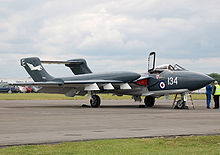
Picture - Preserved Sea Vixen XP924 in England
The prototype took to the skies on 26 September 1951 piloted by John Cunningham; the aircraft's performance exceeded expectations, and by the following year it was regularly flying faster than the speed of sound. However, tragedy struck while the aircraft was being demonstrated at the Farnborough Airshow on 6 September 1952. Following a demonstration of its ability to break the sound barrier, the aircraft disintegrated, killing 31 people, including the crew of two: test pilot and record breaker John Derry and Tony Richards. The failure was traced to faulty design of the end sections of the main spar, which resulted in the outer ends of the wings shearing off during a high-rate turn. The subsequent shift in the DH.110's centre of gravity caused the aircraft to lurch violently, creating forces of over 12 g, resulting in the cockpit and tail sections breaking away and the engines being torn from the airframe. One of the engines impacted in an area crowded with spectators at the end of the runway, causing the majority of casualties. Other spectators were injured by debris from the cockpit impacting close to the main spectator enclosures alongside the runway. This incident led to a major restructuring of the safety regulations for air shows in the UK, and since this accident, no member of the public has died as a result of an airshow accident in the UK.
Owing to this incident, modifications were made to the second prototype, including the fitting of an all-moving tailplane, the modified aircraft not flying again until July 1954. By this time, the RAF had abandoned its interest in the DH.110, choosing instead the Javelin, but the Fleet Air Arm decided to adopt the DH.110 to replace its interim Sea Venoms. The Sea Vixen became the definitive aircraft to dispense with guns, being armed with de Havilland Firestreak air-to-air missiles as apart of an intergrated weapon system. In 1955, a semi-navalised variant was produced as a prototype for the production version, including changes of the leading edge profile and strengthening of the wings, making its first flight that same year. The following year, the aircraft made its first arrested deck landing on the fleet aircraft carrier HMSArk Royal. The first true Sea Vixen, the Sea Vixen FAW.20 (fighter all-weather, later redesignated FAW.1), first flew on 20 March 1957; and on 2 July 1959, the first Sea Vixen equipped squadron formed.
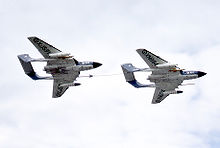
Picture - Two Sea Vixen FAW.1 aircraft (XJ571 & XN694) of 899 Sqn, one refuelling the other at a 1960s Farnborough Air Show
Design
The Sea Vixen had a twin-boom tail, as used on the de Havilland Sea Vampire and Sea Venom. The Sea Vixen became the first British aircraft to be solely armed with missiles, rockets and bombs. The Sea Vixen FAW.1 was armed with four de Havilland Firestreak air-to-air missiles, two Microcell unguided 2inch (51mm) rocket packs and had a capacity for four 500lb (227kg) or two 1,000lb (454kg) bombs. It was powered by two 11,230lbf (50.0kN) thrust Rolls-Royce Avon 208 turbojet engines; had a speed of 690mph (1,110km/h) and a range of 600mi (1,000km). The original DH.110 design as offered to the RAF had cannons fitted; however the cannons were soon removed and an all-missile armament was developed.
The pilot's canopy is offset to the left hand side. The observer is housed to the right completely within the fuselage, gaining access through a flush-fitting top hatch into his position.
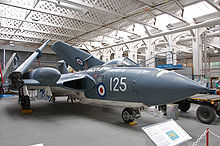
Picture - A Sea Vixen FAW.2 at the Imperial War Museum, Duxford
The Sea Vixen FAW.2 was the successor to the FAW.1 and included many improvements. As well as Firestreak missiles, it could carry the Red Top AAM, four SNEB rocket pods and the air-to-ground Bullpup missile. An enlarged tail boom allowed for additional fuel tanks in the "pinion" extensions above and before the wing leading edge, and there was an improved escape system along with additional room for more electronic counter-measures equipment. However, the changes in aerodynamics meant that the 1,000lb bomb was no longer able to be carried. Visually the FAW.1 and FAW.2 may be distinguished by the tail booms which extend forward over the leading edge of the wing on the FAW.2.
The FAW.2 first flew in 1962 and entered service with front line squadrons in 1964, with 29 being built and a further 67 FAW.1s being upgraded to FAW.2 standard. The FAW.1 began phasing out in 1966. In 1972, the career of the Sea Vixen FAW.2 came to an end. It was planned to replace the Sea Vixen with the F-4 Phantom II, with both HMSArk Royal and Eagle to be refitted to take the new aircraft. In the event, due to defence cuts and following the decommissioning of HMS Eagle, only Ark Royal was converted to take the new aircraft.
A small number of Sea Vixen subsequently saw service in the less glamorous roles of drone, being redesignated Sea Vixen D.3. Only four were converted to the D.3 standard, though three more were sent to Farnborough for conversion but not converted. The last remaining airworthy Sea Vixen was a D3 conversion. Some other Sea Vixens became target tugs and were redesignated as TT.2.
Operational history

Picture - Landing on HMSEagle
The aircraft did not take part in any true wars during its career with the Fleet Air Arm though it took part in many operations. In 1961, President Abdul Karim Kassem of Iraq threatened to annex the neighbouring oil-rich state of Kuwait. In response to Kuwait's appeal for external help, the United Kingdom dispatched a number of ships to the region, including two fleet carriers. Sea Vixens aboard the fleet carriers flew patrols in the region, and Kassem's aggressive actions wilted in the face of the strong naval presence, thus averting a Gulf War over Kuwait.
In January 1964, trouble flared in the East African state of Tanganyika after the 1st and 2nd Tanganyika Rifles mutinied against the British officers and NCOs who, despite Tanganyika being independent, still commanded the regiment. The mutineers also seized the British High Commissioner and the airport at the capital Dar-es-Salaam. The UK responded by sending the light fleet carrier HMSCentaur, accompanied by 45 Commando, Royal Marines. The Sea Vixens, flying off Centaur, performed a number of duties including the providing of cover for the Royal Marines who were landed in Tanganyika by helicopters. The operation to restore Tanganyika to stability ended in success. That same year, Sea Vixens saw service once again in the Persian Gulf, this time supporting British forces fighting against rebellious tribesmen in the Radfan, including the launch of air-strikes against the rebels.
Sea Vixens saw further service during the 1960s, performing duties on Beira Patrol, a Royal Navy operation designed to prevent oil reaching landlocked Rhodesia via the then Portuguese colony of Mozambique. The Sea Vixen also saw service in the Far East. In 1967, once again in the Persian Gulf, Sea Vixens helped cover the withdrawal from Aden. There were a number of Royal Navy warships involved, including the carriers HMSAlbion, Bulwark and Eagle (carrying the Sea Vixens) and the LPD (Landing Platform Dock) HMSFearless.
The Sea Vixen also took to the skies in the aerobatic role, performing in two Royal Navy display teams: "Simon's Sircus" (sic) and "Fred's Five".
A small number of Sea Vixens were sent to FR Aviation at Tarrant Rushton airfield for conversion to D.3 drone standard, with some undergoing testing at RAF Llanbedr before the drone programme was abandoned. Among them was XP924, now G-CVIX, the only Sea Vixen to remain in flying condition, which has now been returned to 899 NAS colours. Owned and operated by De Havilland Aviation, G-CVIX can be viewed at their hangar at Bournemouth Airport in Dorset, southern England, or at air shows around the UK. Many other Sea Vixens remain in good condition but do not fly.
Operators

Picture - 899 Sqn Sea Vixen FAW.2 on Eagle, 1970
Military operators
United Kingdom
Royal Navy Fleet Air Arm
Civilian operators
De Havilland Aviation
Survivors
![Airplane Picture - De Havilland Sea Vixen in sponsored livery at a 2004 airshow. It has since been returned to Royal Navy livery.[23]](images/1-oldimages/220px-Sea.vixen.flying.arp.jpg)
Picture - De Havilland Sea Vixen in sponsored livery at a 2004 airshow. It has since been returned to Royal Navy livery.[23]
Only one Sea Vixen is still airworthy:
Sea Vixen D.3 XP924 (now G-CVIX), De Havilland Aviation, Bournemouth Airport, Dorset.
The following complete airframes also survive:
Sea Vixen FAW.1 XJ481, Fleet Air Arm Museum, RNAS Yeovilton, Somerset. Complete but partially disassembled.
Sea Vixen FAW.1 XJ482, Norfolk and Suffolk Aviation Museum, Suffolk.
Sea Vixen FAW.2 XJ490, Queensland Air Museum, Caloundra, Australia. Airframe complete, but internals removed.
Sea Vixen FAW.2 XJ494, Bruntingthorpe Aerodrome, Leicestershire.
Sea Vixen FAW.2 XJ560, Newark Air Museum, Nottinghamshire.
Sea Vixen FAW.2 XJ565, de Havilland Aircraft Heritage Centre, Hertfordshire.
Sea Vixen FAW.2 XJ571, Solent Sky, Hampshire.
Sea Vixen FAW.2 XJ580, Tangmere Military Aviation Museum, West Sussex.
Sea Vixen FAW.2 XN685, Midland Air Museum, Coventry.
Sea Vixen FAW.2 XS576, IWM Duxford, Cambridgeshire.
Sea Vixen TT.2 XS587 (now G-VIXN), Gatwick Aviation Museum, Surrey.
Sea Vixen FAW.2 XS590, Fleet Air Arm Museum, RNAS Yeovilton, Somerset.
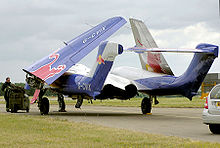
Picture - Sea Vixen, in sponsored livery, at an airshow in the UK (2004).
In addition, a number of partial airframes (principally nose and cockpit sections) survive in private and public collections around the world.
Specifications (Sea Vixen FAW.2)
Data from The Great Book of Fighters
General characteristics
Crew: Two, pilot and Observer
Length: 55 ft 7 in (16.94 m)
Wingspan: 51 ft 0 in (15.54 m)
Height: 10 ft 9 in (3.28 m)
Wing area: 648 ft² (60.2 m²)
Empty weight: 27,950 lb (12,680 kg)
Loaded weight: 41,575 lb (18,860 kg)
Max takeoff weight: 46,750 lb (21,205 kg)
Powerplant: 2x— Rolls-Royce Avon Mk.208 turbojets, 50 kN (11,000 lbf) each
Performance
Maximum speed: Mach 0.91 (690 mph, 1,110 km/h) at sea level
Range: 790 mi (1,270 km) with internal fuel
Service ceiling: 48,000 ft (15,000 m)
Rate of climb: 9,000 ft/min (46 m/s)
Wing loading: 64.2 lb/ft² (313 kg/m²)
Thrust/weight: 0.54
Armament
Hardpoints: 6 and provisions to carry combinations of:
Rockets: 4 x— Matra rocket pods with 18 x— SNEB 68 mm rockets each
Missiles: 4 x— Red Top or Firestreak air-to-air missiles
Bombs: 2 x— 500 lb (227 kg) bombs
Avionics GEC AI.18 Air Interception radar
De Havilland Aviation
1952 Farnborough Airshow DH.110 crash
de Havilland Aircraft Heritage Centre
Portal:British aircraft since World War II
Related development
de Havilland Vampire
de Havilland Venom
Citations
Bibliography
Birtles, Philip. Postwar Military Aircraft 5: de Havilland Vampire, Venom and Sea Vixen. London: Ian Allan, 1986, ISBN 0-7110-1566-X.
Birtles, Philip. "Sea Vixen: Britain's first missile specialist". Air International, April 1991, Vol. 40, No. 4. pp.194-201. Stamford, UK: Key Publishing. ISSN 0306-5634.
Donald, David and Jon Lake, eds. Encyclopedia of World Military Aircraft. London: AIRtime Publishing, 1996. ISBN 1-880588-24-2.
Fiddler, Brian. Sea Vixen. Ilchester, Somerset, UK: The Society of Friends of the Fleet Air Arm Museum, Fleet Air Arm Museum RNAS Yeovilton, 1985, ISBN 0-948251-03-4.
Gunston, Bill. Fighters of the Fifties. North Branch, Minnesota: Specialty Press Publishers & Wholesalers, Inc., 1981. ISBN 0-933424-32-9.
Hobbs, Lt Cdr David. Aircraft of the Royal Navy Since 1945. Liskeard, UK: Maritime Books, 1982, ISBN 0-907771-06-08.
Jackson, A.J. De Havilland Aircraft since 1909. London: Putnam,, Third edition 1987. ISBN 0-85177-802-X.
Neal, Molly. "Sea Vixen." Flight, 5 February 1960. pp. 179-186.
Taylor, John W. R. "De Havilland Sea Vixen". Combat Aircraft of the World from 1909 to the Present. New York: G.P. Putnam's Sons, 1969. ISBN 0-425-03633-2.
Winchester, Jim, ed. "De Havilland DH.110 Sea Vixen." Military Aircraft of the Cold War (The Aviation Factfile). London: Grange Books plc, 2006. ISBN 1-84013-929-3.
Living Warbirds: The best warbirds DVD series.
Source: WikiPedia